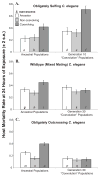Running with the Red Queen: host-parasite coevolution selects for biparental sex - PubMed (original) (raw)
Running with the Red Queen: host-parasite coevolution selects for biparental sex
Levi T Morran et al. Science. 2011.
Abstract
Most organisms reproduce through outcrossing, even though it comes with substantial costs. The Red Queen hypothesis proposes that selection from coevolving pathogens facilitates the persistence of outcrossing despite these costs. We used experimental coevolution to test the Red Queen hypothesis and found that coevolution with a bacterial pathogen (Serratia marcescens) resulted in significantly more outcrossing in mixed mating experimental populations of the nematode Caenorhabditis elegans. Furthermore, we found that coevolution with the pathogen rapidly drove obligately selfing populations to extinction, whereas outcrossing populations persisted through reciprocal coevolution. Thus, consistent with the Red Queen hypothesis, coevolving pathogens can select for biparental sex.
Figures
Fig. 1
Wildtype outcrossing rates over time. Outcrossing rates in wildtype populations were not manipulated and free to evolve during the experiment. The wildtype populations were exposed to three different treatments: control (no S. marcescens; dotted line), evolution (fixed strain of S. marcescens; dashed line), and coevolution (coevolving S. marcescens; solid line) for thirty generations. Error bars represent two standard errors of the mean (SE).
Fig. 2
Coevolutionary dynamics of hosts and pathogens. We exposed hosts evolved under the coevolution treatment and their ancestral populations (prior to coevolution) to three pathogen populations: an ancestor strain (ancestral to all S. marcescens used in this study), a non-coevolving strain (evolved without selection), and their respective coevolving strain (coevolving with the host population). We evaluated host mortality after twenty-four hours of exposure to the pathogens and present the means across the replicate host populations. A. Three obligately selfing C. elegans populations persisted beyond ten host generations in the coevolution treatment. These populations were assayed prior to extinction. B. All five wildtype C. elegans populations in the coevolution treatment and their ancestors were assayed at the endpoint of the experiment (thirty host generations). C. All five obligately outcrossing C. elegans populations in the coevolution treatment and their ancestors were assayed at the endpoint of the experiment. Error bars represent two standard errors of the mean (SE).
Comment in
- Evolution. Sex, death, and the Red Queen.
Brockhurst MA. Brockhurst MA. Science. 2011 Jul 8;333(6039):166-7. doi: 10.1126/science.1209420. Science. 2011. PMID: 21737728 No abstract available.
Similar articles
- Evolution. Sex, death, and the Red Queen.
Brockhurst MA. Brockhurst MA. Science. 2011 Jul 8;333(6039):166-7. doi: 10.1126/science.1209420. Science. 2011. PMID: 21737728 No abstract available. - Temporal dynamics of outcrossing and host mortality rates in host-pathogen experimental coevolution.
Morran LT, Parrish RC, Gelarden IA, Lively CM. Morran LT, et al. Evolution. 2013 Jul;67(7):1860-8. doi: 10.1111/evo.12007. Epub 2012 Dec 20. Evolution. 2013. PMID: 23815644 Free PMC article. - Experimental coevolution: rapid local adaptation by parasites depends on host mating system.
Morran LT, Parrish RC 2nd, Gelarden IA, Allen MB, Lively CM. Morran LT, et al. Am Nat. 2014 Aug;184 Suppl 1(0 1):S91-100. doi: 10.1086/676930. Epub 2014 Jul 17. Am Nat. 2014. PMID: 25061681 Free PMC article. - The ecology of sexual reproduction.
Lively CM, Morran LT. Lively CM, et al. J Evol Biol. 2014 Jul;27(7):1292-303. doi: 10.1111/jeb.12354. Epub 2014 Mar 12. J Evol Biol. 2014. PMID: 24617324 Free PMC article. Review. - Running with the Red Queen: the role of biotic conflicts in evolution.
Brockhurst MA, Chapman T, King KC, Mank JE, Paterson S, Hurst GD. Brockhurst MA, et al. Proc Biol Sci. 2014 Dec 22;281(1797):20141382. doi: 10.1098/rspb.2014.1382. Proc Biol Sci. 2014. PMID: 25355473 Free PMC article. Review.
Cited by
- Discovery of a phenotypic switch regulating sexual mating in the opportunistic fungal pathogen Candida tropicalis.
Porman AM, Alby K, Hirakawa MP, Bennett RJ. Porman AM, et al. Proc Natl Acad Sci U S A. 2011 Dec 27;108(52):21158-63. doi: 10.1073/pnas.1112076109. Epub 2011 Dec 8. Proc Natl Acad Sci U S A. 2011. PMID: 22158989 Free PMC article. - Selective Advantages of a Parasexual Cycle for the Yeast Candida albicans.
Zhang N, Magee BB, Magee PT, Holland BR, Rodrigues E, Holmes AR, Cannon RD, Schmid J. Zhang N, et al. Genetics. 2015 Aug;200(4):1117-32. doi: 10.1534/genetics.115.177170. Epub 2015 Jun 10. Genetics. 2015. PMID: 26063661 Free PMC article. - Bdelloid rotifers deploy horizontally acquired biosynthetic genes against a fungal pathogen.
Nowell RW, Rodriguez F, Hecox-Lea BJ, Mark Welch DB, Arkhipova IR, Barraclough TG, Wilson CG. Nowell RW, et al. Nat Commun. 2024 Jul 18;15(1):5787. doi: 10.1038/s41467-024-49919-1. Nat Commun. 2024. PMID: 39025839 Free PMC article. - Coevolutionary interactions with parasites constrain the spread of self-fertilization into outcrossing host populations.
Slowinski SP, Morran LT, Parrish RC 2nd, Cui ER, Bhattacharya A, Lively CM, Phillips PC. Slowinski SP, et al. Evolution. 2016 Nov;70(11):2632-2639. doi: 10.1111/evo.13048. Epub 2016 Sep 15. Evolution. 2016. PMID: 27593534 Free PMC article. - Evolutionary consequences of self-fertilization in plants.
Wright SI, Kalisz S, Slotte T. Wright SI, et al. Proc Biol Sci. 2013 Jun 7;280(1760):20130133. doi: 10.1098/rspb.2013.0133. Print 2013 Jun 7. Proc Biol Sci. 2013. PMID: 23595268 Free PMC article. Review.
References
- Williams GC. Sex and Evolution. Princeton University Press; Princeton, N.J: 1975.
- Maynard Smith J. The Evolution of Sex. Cambridge University Press; Cambridge, UK: 1978.
- Bell G. The Masterpiece of Nature: The Evolution and Genetics of Sexuality. University of California Press; Berkley, CA: 1982.
- Stebbins GL. Am Nat. 1957;91:337–354.
Publication types
MeSH terms
LinkOut - more resources
Full Text Sources
Other Literature Sources

